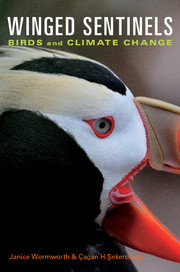Book contents
- Frontmatter
- CONTENTS
- ACKNOWLEDGEMENTS
- Introduction: The Free Advice of Birds
- Chapter 1 Phenology: Seasonal Timing and Mismatch
- Chapter 2 Migratory Birds Face Climate Turbulence
- Chapter 3 Range Shifts and Reshuffled Communities
- Chapter 4 Seabirds Herald Ocean Changes
- Chapter 5 Climate Change, Abundance and Extinction
- Chapter 6 Tropical Warming and Habitat Islands
- Chapter 7 Shifting Ground on Conservation
- NOTES
- INDEX
- PLATE SECTION
- PLATE SECTION
- PLATE SECTION
Chapter 6 - Tropical Warming and Habitat Islands
Published online by Cambridge University Press: 05 March 2012
- Frontmatter
- CONTENTS
- ACKNOWLEDGEMENTS
- Introduction: The Free Advice of Birds
- Chapter 1 Phenology: Seasonal Timing and Mismatch
- Chapter 2 Migratory Birds Face Climate Turbulence
- Chapter 3 Range Shifts and Reshuffled Communities
- Chapter 4 Seabirds Herald Ocean Changes
- Chapter 5 Climate Change, Abundance and Extinction
- Chapter 6 Tropical Warming and Habitat Islands
- Chapter 7 Shifting Ground on Conservation
- NOTES
- INDEX
- PLATE SECTION
- PLATE SECTION
- PLATE SECTION
Summary
Habitat islands in a warming world
Bird architects of dinosaur forests
… the playing passages of bower-birds are tastefully ornamented with gaily-coloured objects; and this shews [sic] that they must receive some kind of pleasure from the sight of such things.
Charles Darwin, 1871Golden bowerbirds, Prionodura newtoniana, of the Wet Tropics of Queensland embody the uniqueness of tropical mountain wildlife, and its vulnerability in a warming world. An undulating landscape of warm lowlands and cool highlands in north-east Australia, this bioregion abounds with rainforest life found nowhere else on Earth. As its climate changed over millions of years, forested upland islands of coolness were isolated from one another by warmer lowland barriers, accelerating the rise of new species. Home to some of the world's oldest continually surviving tropical rainforest, it also harbours descendents of archaic Gondwanan forms of life. Today, at least 700 vascular plants are endemic, found only in the Wet Tropics.
The golden bowerbird is one of 13 endemic birds. It courts and breeds in patchy tracts of cooler, upland and highland rainforest between altitudes of 700 and 1500 metres, sharing an unusual mating strategy with other bowerbirds, medium-sized passerines of Australia, New Guinea and their adjacent islands. To attract mates, bowerbird males build displays, or bowers. Charles Darwin concurred with English ornithologist and artist John Gould that these ‘must be regarded as the most wonderful instances of bird-architecture yet discovered’. Papuan men are said to admire bowerbirds for their adeptness in acquiring what they see as the avian equivalent of a ‘bride price’, the wealth accumulated to pay for a wife.
- Type
- Chapter
- Information
- Winged SentinelsBirds and Climate Change, pp. 162 - 192Publisher: Cambridge University PressPrint publication year: 2011



